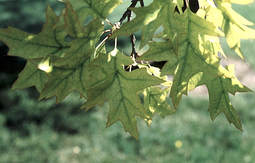
Classic symptoms of iron chlorosis are yellow leaves with a network of dark green veins. In severe cases the entire leaf turns yellow and the edges of the leaf scorch and turn brown. Plants may eventually die.
One of the best methods of avoiding iron chlorosis is by planting tolerant trees. Trees that are susceptible to iron chlorosis include pin oak, sweetgum, and dawn redwood. Moderately tolerant trees are ash, cottonwood, linden, elm, hawthorn, most oaks and ginkgo. Even closely related trees can differ markedly in their resistance. For example, pin oak is notorious for sensitivity to iron chlorosis while most other oaks are moderately tolerant. Also, red, silver and Amur maples are susceptible, but Norway maples are much less so. Several methods are used to correct iron chlorosis in trees. Not all methods work in all situations. The following are the most common.
Soil treatment: The idea is to acidify a small quantity of soil so the tree can absorb the iron it needs from these areas. This will only work on non calcareous soils.
If the tree has not been planted yet, have a soil test done. Add the recommended amount of sulfur (if any) and work into the soil before planting.
For existing trees, a mixture of equal parts of iron sulfate and elemental sulfur are mixed together, and the mixture is placed in holes made under the dripline of the tree. Holes should be 1 to 2 inches in diameter and 12 to 18 inches deep. Space them 18 to 24 inches apart. Each hole should be filled with the iron sulfate elemental sulfur mixture to within 4 inches of the soil surface. This method is labor intensive and results can vary.
Iron chelates: Iron chelates can also be used as a soil treatment. The only chelate that is effective above a soil pH of 7.2 is Iron EDDHA. It can be found in the products Sequestar 6% Iron Chelate WDG, Sequestrene 138 and Millers FerriPlus.
Use these products in the spring before growth starts. Dry chelate can be sprinkled on the soil and watered in or dissolved in water and applied as a drench under the dripline of the tree. Normally, soil applied chelates last only one year.
Trunk injection or implantation: In this method, holes are drilled in the lower trunk and ferric ammonium citrate (iron citrate) is introduced through the holes. Successful applications often last several years. The preferred time of application is during the spring just after the leaves have fully expanded. Use a brad point drill bit to minimize tree wounding. Research has shown the uptake is enhanced if the holes are drilled in the root flares near the soil surface. (Ward Upham)
 RSS Feed
RSS Feed
